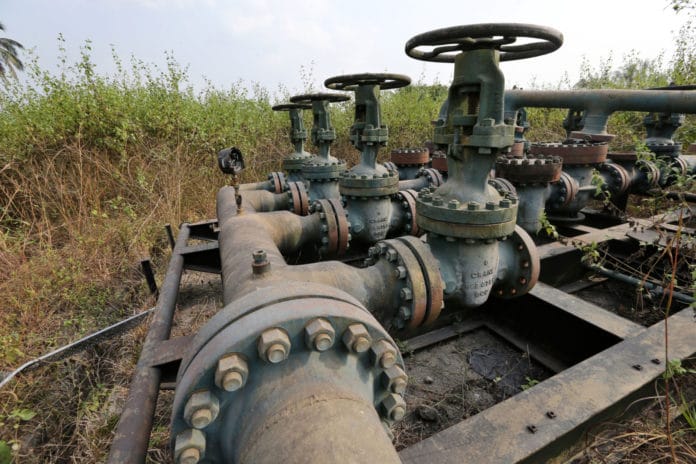Leftist guerrillas in Colombia, rebels in Libya and militants in Nigeria are succeeding where the world’s biggest oil producers failed, helping keep a 1.5 million-barrel crude surplus from expanding.
While Saudi Arabia, Russia and other major producers couldn’t agree on a production freeze earlier this month, disruptions ranging from pipeline attacks to field shutdowns have taken 800,000 barrels a day of crude supply offline this year, according to energy-industry consultant FGE. As the collapse in oil prices cuts their revenue, producers in some parts of the world are finding it harder to keep supplies flowing, according to Citigroup Inc.
“The fact of the matter is that the oversupply in the market is very narrow,” said Ed Morse, head of commodities research at Citigroup. “The world has become highly prone to disruptions of supply in vulnerable petro states.”
An effort by the largest oil-producing countries to seal a deal to freeze production failed after an April 17 meeting among OPEC members and nations outside the group in Doha, Qatar, ended without producing an agreement. “The focus on Doha did miss the biggest elephants not in the room,” said Morse, referring to the supply disruptions, which have helped drive a surge in prices since February.
Nigeria offers a clear window into the effects of the outages. Africa’s largest crude-producing nation is pumping about 1.7 million barrels a day, according to the Paris-based IEA. That’s the country’s lowest production level since 2009.
The decline comes as an export terminal for the nation’s Forcados crude is expected to remain shut until June because of a leak that the facility’s operator, Royal Dutch Shell, says was caused by damage “consistent with the application of external force.” Shipments of another grade, Brass River, were disrupted because of a pipeline fire.
Brass River shipments averaged 128,000 barrels a day last year, amounting to about 6 percent of Nigeria’s total cargoes, while the nation supplied about 200,000 barrels from Forcados daily in 2015, according to loading programs compiled by Bloomberg.
There’s mounting concern that the country’s oil-rich Niger River delta may return to the sort of violence seen in the last decade, before a peace deal was struck in 2009. A campaign by the recently elected government to end corruption in an amnesty program for former rebels has caused grievances, and attacks on energy facilities in the region have been gathering pace.
Similar issues have erupted in Libya, the holder of Africa’s largest oil reserves, since the rebellion that ended Moammar Gadhafi’s rule in 2011. The country has been remade into separately-run regions, and various armed militias compete for control of its oil fields and related facilities. Three crude ports in the nation have been closed for more than a year.
Libya pumped about 1.6 million barrels a day of crude before the 2011 rebellion. It’s now the smallest producer in the Organization of Petroleum Exporting Countries, supplying 330,000 barrels a day in March, data compiled by Bloomberg show. Arabian Gulf Oil Co., a unit of the country’s National Oil Corp. known as Agoco, has reduced output to 130,000 barrels a day from 230,000 barrels due to a lack of storage capacity at Hariga port, a company official said April 27.
“Libya, Nigeria are wildcards, and they’re ongoing and will always be unpredictable,” said John Driscoll, chief strategist at JTD Energy Services Pte, who has spent more than 30 years trading crude and petroleum in Singapore. “We can’t ignore them from a fundamental perspective, as these disruptions, strikes, sabotages and explosions add to outages. They have to be factored into the market.”
The price of Brent crude, the benchmark for more than half the world’s oil, also illustrates the impact of the outages. Cargoes for prompt delivery have become 29 cents a barrel costlier than later shipments in a market structure called backwardation that typically indicates a supply squeeze. Short-term contracts were at a discount, or contango, earlier this year.
Africa isn’t alone in facing disruptions.
Attacks by Marxist guerrillas also disrupted supplies from Colombia, where production has dropped to 916,000 barrels a day in March, a decline of 8 percent from December levels. The country’s daily crude exports slid 14 percent from a month earlier to about 622,000 barrels in March, according to a shipping report, U.S. Customs and ship-tracking data compiled by Bloomberg.
The Latin American nation’s government has held peace talks with the Revolutionary Armed Forces of Colombia, or FARC, since 2012, and last month said it would also begin talks with the smaller National Liberation Army, or ELN. Both groups have been fighting the state since the 1960s.
“Above-land pipelines and facilities in remote areas make some of this infrastructure hard to secure and guard against attacks, considering the ongoing history of civil unrest in some of these countries,” said Tushar Tarun Bansal, a senior consultant in Singapore at FGE. “If a pipeline is passing nearby, then that’s a soft target.”
Meanwhile, supplies from Iraq have also been affected, Europe’s North Sea fields are preparing to shut for maintenance and the downturn in the energy industry has taken a toll on drilling in nations including the U.S. and Venezuela. The International Energy Agency estimates the crude glut will reduce 87 percent to 200,000 barrels a day in the second half of 2016 as output from non-OPEC nations slides the most in 25 years.
“What the unplanned outages have done is to create the supply curtailments that were needed to erode the overhang,” said Peter Lee, an analyst with Fitch Group’s BMI Research. Freezing output may “have some impact on market sentiment in the short-term, but what drives prices in the long term will be what happens to actual supply.”






